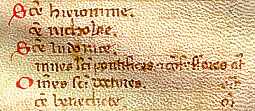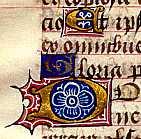




If you are looking at this page without frames, there is more information about medieval writing to be found by going to the home page (framed) or the site map (no frames).
| Initials and Borders (4) | |||
| The planning of decorative elements such as initials and borders occurred at the beginning of the process of book design. The scribe who transcribed the main text left appropriate spaces for fancy initials, sometimes with coded instructions which would be painted over when the initial was produced later by a specialist craftsman. The grand and glamourous manuscripts may show us the final result, but a peep at a few modest, and in some cases unfinished, examples indicates how the work was organised. | |||
 |
Segment of a page from a 15th century book of hours from northern France, from a private collection. | ||
| This little segment from a Latin book of hours shows several of the processes in making up a book. The inked guidelines in which to enter the text are clearly visible, and on either side of the page you can just make out what looks like rows of pinholes. In fact, these are exactly what they are, as these prickings were made through several sheets of parchment to serve as guides for drawing up the writing grid. The row of holes was trimmed off before binding, but this leaf was never finished. The blank space on the left has been left for the addition of an initial, which is indicated to be Q by the small letter q in the space, to create the word Quis. As can be seen, the rubrics have already been added, as has some yellow highlighting to some letters. Now I wonder why it wasn't finished, and how, despite this, it managed to survive for over 500 years! | |||
 |
Segment from a page of a psalter of c.1500, from a private collection. | ||
| The process of the scribe leaving a space for another craftsman to enter the initials was not confined to highly elaborate illuminated initials. The simple blue inked initial O shown above on a page of a fairly roughly written Latin psalter shows the little guide o inked in the middle. Interestingly enough, this page also retains its pricking holes, so I wonder whether the various red and blue inked initials on the page are actually complete. | |||
 |
Segment of a page from a late 15th century Italian book of hours, from a private collection. | ||
| This segment of a page from an exceedingly modest book of hours on abominable parchment with ink faded to brown shows part of the litany. Only every second initial has been added in, and all of these are red. I assume it was intended to have alternating red and blue initials, but for some reason the blue ones were never completed. Isn't it interesting what you can learn by ransacking medieval wastepaper baskets via the modern internet? | |||
 |
Segment from an early 16th century book of hours from France, from a private collection. | ||
| One might think that everybody involved in the production of expensive books would have been fully literate, but sometimes the mistakes found on medieval manuscript pages make you wonder. This segment is from a page of a Latin book of hours of the early 16th century, when printed books of hours had already become available. The illuminated initials are not built up three dimensionally with gesso and gold leaf, but flat, the gold having been applied as a liquid suspension. The funny thing is, the upper initial, which appears to be a T, at the beginning of the rubric, is quite extraneous, and furthermore partially obscures a letter on the line above. The illuminator was presumably very tricky with his gold ink, but not so fancy with his Latin. Gold handpainted initials were added to printed books of hours by the same process. | |||
 |
Illuminated intials from a late 15th century French book of hours, from a private collection. | ||
| And here, just to show what happened when they didn't make a mess of it, is a set of beautiful little illuminated initials from the sort of book that would have belonged to an ordinary layman, albeit one of some means. The upper and lower initials are three dimensional and built on gesso. The middle one is done with gold paint. Surely one of the functions of these decorations was to bring into the home and hands of the owner some of that colour, mystery and magic that he or she would otherwise only encounter in the stained glass windows of the church. | |||
|
|
|||
|
If you are looking at this page without frames, there is more information about medieval writing to be found by going to the home page (framed) or the site map (no frames). |
|||